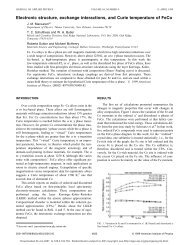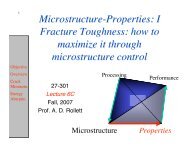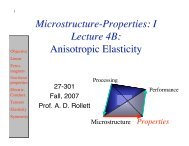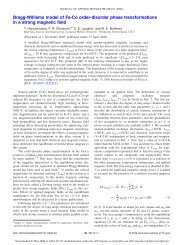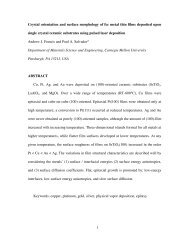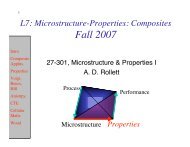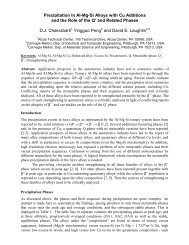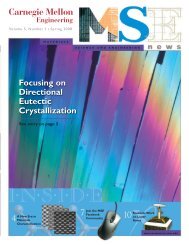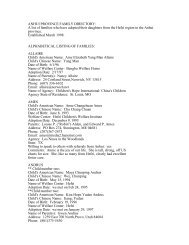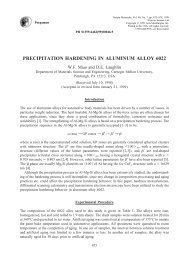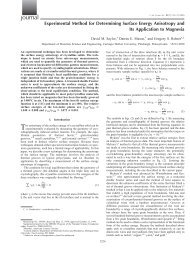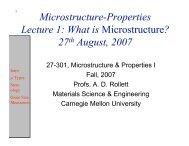Recrystallization Theoretical & Practical Aspects - Materials Science ...
Recrystallization Theoretical & Practical Aspects - Materials Science ...
Recrystallization Theoretical & Practical Aspects - Materials Science ...
You also want an ePaper? Increase the reach of your titles
YUMPU automatically turns print PDFs into web optimized ePapers that Google loves.
Intro<br />
<strong>Recrystallization</strong><br />
Lab 1<br />
Grain<br />
Boundaries<br />
<strong>Recrystallization</strong><br />
<strong>Theoretical</strong> & <strong>Practical</strong> <strong>Aspects</strong><br />
27-301, Microstructure & Properties I<br />
Fall 2006<br />
Supplemental Lecture<br />
A.D. Rollett, M. De Graef<br />
<strong>Materials</strong> <strong>Science</strong> & Engineering<br />
Carnegie Mellon University<br />
1
Intro<br />
<strong>Recrystallization</strong><br />
Lab 1<br />
Grain<br />
Boundaries<br />
Objectives<br />
• The main objective of this lecture is to introduce you<br />
to the process of recrystallization and to prepare<br />
you for a laboratory exercise on this topic.<br />
• You will have mastered the material in this lecture if<br />
you can describe the process in qualitative terms,<br />
can relate it to thermomechanical processing in<br />
general and know how to apply Johnson-Mehl-<br />
Avrami-Kolmogorov analysis to the kinetics.<br />
2
Intro<br />
<strong>Recrystallization</strong><br />
Lab 1<br />
Grain<br />
Boundaries<br />
<strong>Recrystallization</strong> Basics<br />
• <strong>Recrystallization</strong> is essential to thermomechanical<br />
processing of metallic materials. Plastic<br />
deformation stores energy in the form of<br />
dislocations and also distorts the shape of the<br />
grains. <strong>Recrystallization</strong> restores the material to<br />
an undeformed state.<br />
• Static recrystallization occurs on heating the<br />
deformed material to an elevated temperature.<br />
• Dynamic recrystallization occurs during the<br />
plastic deformation. This only occurs for hot<br />
deformation at temperatures greater than 0.5 of the<br />
melting point.<br />
3
Intro<br />
<strong>Recrystallization</strong><br />
Lab 1<br />
Grain<br />
Boundaries<br />
Microstructures<br />
The microstructure<br />
gradually changes<br />
from one with<br />
elongated,<br />
deformed grains to<br />
one with<br />
undeformed,<br />
equiaxed grains.<br />
Aluminum Handbook, Hatch<br />
(1984).<br />
4
Intro<br />
<strong>Recrystallization</strong><br />
Lab 1<br />
Grain<br />
Boundaries<br />
Annealing Processes<br />
• <strong>Recrystallization</strong> is one example of a process that occurs<br />
during annealing of materials. Annealing is simply the<br />
exposure of a material to elevated temperature for a specified<br />
period of time. Various thermally activated processes<br />
occur during annealing that the materials engineer seeks<br />
to control in order to optimize properties.<br />
• Other processes include recovery, grain growth, carburization,<br />
and sintering.<br />
• Recovery is the decrease of dislocation density that occurs by<br />
motion and annihilation of individual dislocations.<br />
• Grain growth is the coarsening of the grain structure by<br />
motion of grain boundaries.<br />
• Carburization is an example of a change of chemical<br />
composition near the surface brought about by the presence of<br />
a high chemical potential for carbon (e.g. by having CO in the<br />
furnace atmosphere) during annealing. This is important in<br />
steels for producing high hardnesses at the surface of a<br />
material.<br />
5
Intro<br />
<strong>Recrystallization</strong><br />
Lab 1<br />
Grain<br />
Boundaries<br />
<strong>Recrystallization</strong>: mechanisms<br />
• The basic mechanism of recrystallization is the<br />
(long-range) motion of grain boundaries that<br />
removes dislocation density from the material.<br />
• A consequence of the requirement for longrange<br />
boundary migration is that<br />
recrystallization is a thermally activated<br />
process.<br />
• In most materials, temperatures > T m/3 are required<br />
for recrystallization to proceed at a measurable rate.<br />
• Why? Grain boundaries are slowed down by the<br />
presence of solute and most practical materials<br />
have significant amounts of solute.<br />
6
Intro<br />
<strong>Recrystallization</strong><br />
Lab 1<br />
Grain<br />
Boundaries<br />
<strong>Recrystallization</strong>: measurement<br />
• How can we measure recrystallization?<br />
• The traditional method is to perform optical<br />
metallography on sectioned samples.<br />
Recrystallized grains appear as approximately<br />
equiaxed grains with uniform color. Unrecrystallized<br />
grains appear as deformed grains with irregular<br />
contrast.<br />
• Measurement is primarily the area fraction of<br />
recrystallized versus unrecrystallized material.<br />
Stereology tells us that this area fraction is<br />
equivalent to the volume fraction of recrystallized<br />
material.<br />
• An easier measurement is hardness which<br />
decreases during the recrystallization process.<br />
7
Intro<br />
<strong>Recrystallization</strong><br />
Lab 1<br />
Grain<br />
Boundaries<br />
<strong>Recrystallization</strong> Characteristics<br />
• In order for the boundary between a new grain (nucleus) and<br />
the deformed material to be able to move, it must be a high<br />
angle boundary. This is a consequence of the properties of<br />
boundaries, to be described later.<br />
• The requirement that new grains have high angle boundaries<br />
means that the final grain size and the rate at which<br />
recrystallization takes place is highly dependent on the strain<br />
level.<br />
• Higher strains mean greater lattice rotations (from dislocation<br />
slip) inside grains and higher stored energies. Therefore the<br />
probability of generating new grains increases with strain and<br />
the driving force increases.<br />
• Increasing probability for nucleation translates directly into<br />
increased density of nuclei and therefore smaller recrystallized<br />
grain size.<br />
8
Grain size as a function of prior<br />
deformation level<br />
• The grain size after<br />
recrystallization decreases<br />
with increasing prior strain,<br />
i.e. the nucleation density<br />
increases.<br />
• Example of commercial<br />
purity Al, recrystallized at<br />
Intro 600°C (1.5h) after 2 (top), 6,<br />
Recryst- 8 & 10% (bottom) reduction<br />
allization in tensile strain.<br />
Lab 1<br />
• Note that these are very<br />
small strains compared to<br />
Grain commercial practice.<br />
Boundaries<br />
• Next slide shows industrial<br />
data on grain size, also for<br />
commercial purity aluminum.<br />
9
Intro<br />
<strong>Recrystallization</strong><br />
Lab 1<br />
Grain<br />
Boundaries<br />
Strain dependence<br />
Aluminum Handbook, Hatch (1984).<br />
• In most materials, the grain size after recrystallization<br />
decreases as the strain increases. For most applications,<br />
small grain size is desirable. Certain applications, however,<br />
require large grain size, and so small strains are sometimes<br />
used.<br />
• Note that the heating rate has essentially no effect on the<br />
10<br />
outcome of recrystallization.
Intro<br />
<strong>Recrystallization</strong><br />
Lab 1<br />
Grain<br />
Boundaries<br />
Strain effect on kinetics<br />
• <strong>Recrystallization</strong> takes place more rapidly as the deformation<br />
strain increases. This work was performed at Carnegie Tech.<br />
[Humphreys]<br />
11
Intro<br />
<strong>Recrystallization</strong><br />
Lab 1<br />
Grain<br />
Boundaries<br />
Temperature dependence<br />
• The growth of new grains requires motion of grain<br />
boundaries. Boundary migration occurs by the<br />
transfer of atoms across the boundary which is a<br />
diffusion-like process.<br />
• Solutes have a strong effect on boundaries because<br />
the interaction leads to segregation (generally an<br />
excess of solute on the boundary). In effect, moving<br />
the boundary forces the solute to move with it.<br />
• A suitable measure of the “reaction rate” is the time<br />
for 50% recrystallization.<br />
12
Intro<br />
<strong>Recrystallization</strong><br />
Lab 1<br />
Temperature Effect on Rex kinetics<br />
Grain<br />
Boundaries<br />
• <strong>Recrystallization</strong> is a<br />
thermally activated<br />
process and therefore<br />
proceeds more rapidly<br />
as the temperature<br />
increases.<br />
• Note that the rate of<br />
recrystallization is<br />
measured by the time<br />
required for 50%<br />
recrystallization.<br />
[Humphreys]<br />
13
Intro<br />
<strong>Recrystallization</strong><br />
Lab 1<br />
Impurity effects on recrystallization<br />
Grain<br />
Boundaries<br />
V (cm.s -1 )<br />
1/T<br />
decreasing Fe content<br />
F. R. Boutin, J. Physique, C4,<br />
(1975) C4.355.<br />
increasing Cu content<br />
R. Vandermeer and P. Gordon, Proc.<br />
Symposium on the Recovery and<br />
<strong>Recrystallization</strong> of Metals, New York,<br />
TMS AIME, (1962) p. 211.<br />
14
Intro<br />
<strong>Recrystallization</strong><br />
Lab 1<br />
Grain<br />
Boundaries<br />
Nucleation & Growth<br />
• Based on the microstructural characteristics (a<br />
different type of material appears as dispersed<br />
‘particles’ and grows to the point of replacing the<br />
deformed material), recrystallization is classified as<br />
a ‘nucleation & growth’ phenomenon.<br />
• Although treating recrystallization as a nucleation &<br />
growth process is perfactly adequate, more detailed<br />
examination shows that it is actually a continuous<br />
coarsening process. The coarsening is, however,<br />
so highly heterogeneous that classification depends<br />
on the length scale at which it is characterized.<br />
15
Intro<br />
<strong>Recrystallization</strong><br />
Lab 1<br />
Grain<br />
Boundaries<br />
Nucleation & Growth<br />
• Two steps are required for recrystallization to<br />
proceed:<br />
– (a) nucleation of new grains that are dislocation-free<br />
– (b) growth of the new grains into the dislocated matrix<br />
Deformed matrix<br />
New grains<br />
16
Intro<br />
<strong>Recrystallization</strong><br />
Lab 1<br />
Grain<br />
Boundaries<br />
Source of stored energy<br />
• Martin, Doherty & Cantor distinguish between<br />
microstructural changes driven by chemical energy<br />
and change driven by strain energy.<br />
• <strong>Recrystallization</strong> is a process of microstructural<br />
change driven by strain energy.<br />
• We will examine the details of plastic deformation<br />
later in the course. For now, it is sufficient to know<br />
that plastic deformation requires a high level of<br />
dislocation activity on at least 5 slip systems in each<br />
grain. Dislocations intersect and multiply leaving<br />
behind a highly irregular structure. This storage of<br />
dislocation line length is the direct cause of work<br />
hardening and is the strain energy that drives<br />
recrystallization.<br />
17
Intro<br />
<strong>Recrystallization</strong><br />
Lab 1<br />
Grain<br />
Boundaries<br />
Nucleation Issues<br />
• Nucleation in recrystallization must be a<br />
heterogeneous nucleation process because the<br />
driving force is too small to sustain homogeneous<br />
nucleation.<br />
• Estimate of driving force, E:<br />
– Energy per unit length of dislocation ≈ Gb 2<br />
– Thus energy/volume, E ≈ Gb 2 ρ<br />
– Typical cold worked dislocation density, ρ = 10 15 .m -2<br />
– For Al, G = 27GPa, b =0.28nm,E ≈ 2 J.m -3 ( = 2MPa)<br />
– For a boundary energy σ = 0.5 J.m -2 , the critical nucleus<br />
size, r crit = 2σ/Ε 2 ≈ 0.25µm,<br />
which is a very large (too large!) critical radius.<br />
• Therefore nucleation in recrystallization must be<br />
heterogeneous.<br />
18
Intro<br />
<strong>Recrystallization</strong><br />
Lab 1<br />
Grain<br />
Boundaries<br />
Heterogeneous Nucleation<br />
• Nucleation of recrystallization therefore occurs on<br />
defects in the material.<br />
• Sites for nucleation:<br />
– Prior grain boundaries (strain induced boundary migration,<br />
SIBM)<br />
– Deformation bands or shear bands, i.e. regions of nonuniform<br />
rotation of the lattice<br />
– Coarsening (recovery) of a subgrain structure<br />
– Coarsening (recovery) of dislocation structure near to<br />
coarse particles; this is called Particle Stimulated<br />
Nucleation (PSN).<br />
19
Intro<br />
<strong>Recrystallization</strong><br />
Lab 1<br />
Grain<br />
Boundaries<br />
Growth of New Grains<br />
• The interface between a new grain and the<br />
deformed (unrecrystallized) material (“matrix”) is a<br />
grain boundary.<br />
• Grain boundaries vary in their mobility, M, i.e. the<br />
constant of proportionality between migration rate, v,<br />
and driving force, E.<br />
• Assume a linear relationship: v = ME.<br />
• The driving force is exactly the stored energy<br />
estimated previously.<br />
• (HAGB) High angle grain boundaries (θ>15°) are<br />
typically far more mobile than (LAGB) low angle<br />
boundaries (by orders of magnitude).<br />
20
Intro<br />
<strong>Recrystallization</strong><br />
Lab 1<br />
Grain<br />
Boundaries<br />
Laboratory 1 - Introduction<br />
• The objectives of the first Lab are as follows:<br />
– Demonstrate recrystallization<br />
– Develop metallography skills<br />
– Ability to measure grain size<br />
– Ability to measure hardness<br />
– Demonstrate effect of strain on recrystallized grain size<br />
– Demonstrate effect of temperature on recrystallized grain<br />
size<br />
– Demonstrate effect of strain on hardness<br />
– Demonstrate effect of temperature on hardness<br />
– Demonstrate the Hall-Petch effect<br />
– Promote critical thinking about the reasons for the variations<br />
in grain size and hardness observed<br />
21
Intro<br />
<strong>Recrystallization</strong><br />
Lab 1<br />
Grain<br />
Boundaries<br />
Lab. 1- Apparatus<br />
• The approach is to deform a rectangular piece of<br />
brass and then anneal it in a temperature gradient.<br />
The brass specimen is machined to have a wedge<br />
shape so that when it is deformed (rolled), the strain<br />
varies from the thin side to the thick side.<br />
• Download the Lab Manual from Blackboard in order<br />
to obtain further details.<br />
22
Intro<br />
<strong>Recrystallization</strong><br />
Lab 1<br />
Grain<br />
Boundaries<br />
Lab. 1- Apparatus, contd.<br />
• The specimen is suspended by a wire within an<br />
induction coil. The lower end dips into a beaker of<br />
water in order to maintain one end at (a maximum<br />
temperature of) the boiling point of water.<br />
Induction<br />
Coil<br />
Water<br />
HOT<br />
COLD<br />
Procedure: apply<br />
heat and observe<br />
the temperature at<br />
the top of the<br />
specimen (T/C).<br />
Stop the heating<br />
once T=900°C; cut<br />
the wire so that the<br />
specimen falls into<br />
the water and is<br />
quenched.<br />
23
Intro<br />
<strong>Recrystallization</strong><br />
Lab 1<br />
Grain<br />
Boundaries<br />
Lab 1 - Expected Results<br />
• Hardness: before recrystallization, the hardness should<br />
increase with increasing strain (hint - relate this to what you<br />
know about stress-strain behavior in metals).<br />
• After recrystallization, the grain size will increase with<br />
increasing temperature, but decrease with increasing prior<br />
strain.<br />
• Also after recrystallization, the hardness will increase with<br />
decreasing grain size (Hall-Petch effect) in the recrystallized<br />
areas.<br />
• Note: a critical part of the Lab is to obtain high quality images<br />
of the grain structure so that you can measure grain size. The<br />
metallography involved requires skill and effort. Also,<br />
computer-based submissions are required (Word, or LaTex).<br />
24
Intro<br />
<strong>Recrystallization</strong><br />
Lab 1<br />
Grain<br />
Boundaries<br />
What is a Grain Boundary?<br />
• Grain boundaries control the process of<br />
recrystallization. This suggests that it is worth<br />
knowing something about the structure and<br />
properties of boundaries.<br />
• Regular atomic packing disrupted at the boundary<br />
by the change in lattice directions.<br />
• In most crystalline solids, a grain boundary is very<br />
thin (one/two atoms).<br />
• Disorder (broken bonds) unavoidable for<br />
geometrical reasons; therefore large excess free<br />
energy. This interfacial energy is analogous to the<br />
surface tension in a soap bubble (and many<br />
investigations on grain growth have been made with<br />
soap froths).<br />
25
Intro<br />
<strong>Recrystallization</strong><br />
Lab 1<br />
Grain<br />
Boundaries<br />
Crystal orientations at a g.b.<br />
g D<br />
TJ ABC<br />
g B<br />
g Bg A -1<br />
g A<br />
TJ ACB<br />
g C<br />
26
Intro<br />
<strong>Recrystallization</strong><br />
Lab 1<br />
Grain<br />
Boundaries<br />
Grain Boundary Structure<br />
• High angle boundaries: can be thought of as two<br />
crystallographic planes joined together (with or w/o a<br />
twist of the lattices).<br />
• Low angle boundaries are arrays (walls) of<br />
dislocations: this is particularly simple to understand<br />
for pure tilt boundaries [to be explained].<br />
• Grain boundary energy increases monotonically with<br />
misorientation as a consequence of increasing<br />
dislocation density.<br />
• Transition: in the range 10-15°, the dislocation<br />
structure changes to a high angle boundary<br />
structure.<br />
• The grain boundary mobility increases abruptly at<br />
this transition in structure.<br />
27
Intro<br />
<strong>Recrystallization</strong><br />
Lab 1<br />
Grain<br />
Boundaries<br />
LAGB to HAGB Transitions<br />
• The Read-<br />
Shockley equation<br />
describes the<br />
energy of low<br />
angle boundaries.<br />
• An exponential<br />
function is useful<br />
for describing the<br />
sharp transition in<br />
mobility from lowto<br />
high-angle<br />
boundaries<br />
Energy, Mobility<br />
1<br />
0.8<br />
0.6<br />
0.4<br />
0.2<br />
c1=c0/15.*(1.-ln(c0/15.))<br />
Energy<br />
Mobility<br />
c2=1.-0.99*exp(-.5*(c0/15)^9)<br />
0<br />
0 5 10 15 20 25<br />
Angle (°)<br />
28
Intro<br />
<strong>Recrystallization</strong><br />
Lab 1<br />
Grain<br />
Boundaries<br />
Example: tilt boundary = array<br />
of parallel edge dislocations<br />
b<br />
• Low angle boundaries are arrays of parallel edge<br />
dislocations if the rotation between the lattices is<br />
small and the rotation axis lies in the boundary<br />
plane. In this example, the rotation axis between<br />
the two crystals is perpendicular to the plane of the<br />
picture.<br />
29



